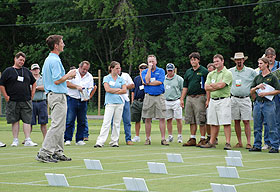  |
| HOME | THIS ISSUE | CALENDAR | GRANTS | BACK ISSUES | < BACK | NEXT > |
Plant Science's turfgrass program showcased during open houseby David Bauman - September 2, 2008
|
||||
| Different turfgrass species have dramatically different water needs in the summertime, according to turfgrass scientist Jason Henderson, an assistant professor in the Department of Plant Science. He spoke about low maintenance turfgrass species during UConn’s first Turfgrass Field Day hosted by the plant science department on the Storrs campus in July. Nearly 350 people attended the day-long event, including sports turf managers, golf course superintendents, sod farm owners, landscape architects and contractors, industry representatives, and lawn and garden professionals from across New England. Gregory Weidemann, the new dean of the College of Agriculture and Natural Resources, said the event “sends a strong signal to the landscaping industry that UConn’s turfgrass program has come of age and has no place to go but grow.” Management of turf grasses has become a lucrative part of the economy. Nationwide, golf alone generated $76 billion in 2005 and employed more than 2 million people. In Connecticut, the golf industry contributes an estimated $1 billion to the state’s economy. There are currently about 180 golf courses in the state, with more being planned. About two-thirds of UConn’s turfgrass program’s graduates end up working in the golf industry; while another third take jobs in grounds keeping, recreation field maintenance, or other sport-related field management. Turfgrass is a species of grass that is maintained as a mowed turf. It is used in home lawns, parks, cemeteries, sports fields, schoolyards, and roadsides. Turfgrass originated from meadow and range grasses that thrived under close grazing by livestock. Professional turfgrass managers blend the technical expertise of turfgrass culture and physiology with the challenges of managing insects, diseases, and weed populations to keep turf areas green and healthy. The turfgrass field day was designed to showcase current research projects in the areas of professional and residential turfgrass management, according to John Kaminski, an assistant professor of plant science, who helped organize the event.
The morning featured plot tours and presentations by UConn turfgrass researchers in the areas of golf and sports turf management and nutrient and organic management practices, as well as demonstrations of the latest equipment by professional turf equipment manufacturers. Afternoon workshops addressed disease control, weed identification, organic approaches to lawn maintenance, and a tour of UConn’s athletic fields to see how they are prepared for Division I level competition. Henderson, who is involved in several research projects in golf and sports turf management, is part of a team of turf scientists nationwide that is investigating the impact of rolling and mowing heights on putting green quality and turfgrass health. Data from alternative rolling/mowing frequency programs were collected on eight plots at the UConn research facility this summer. Similar rolling/mowing frequency treatments using identical equipment but on different grass species were performed at Michigan State University, the University of Arkansas, and the University of Tennessee. Henderson hopes the findings will offer turfgrass managers in various regions of the country concrete data on which to formulate better management options for their greens. “Mowing is stressful to the plant,” he said. “The plant is not working as well during 90 degree days in August as during 80 degree days in May. That’s why if we can reduce mowing and still maintain green speed with rolling, we can protect the plant, reduce disease, and keep high quality greens for golf players.” |
| ADVANCE HOME UCONN HOME |

